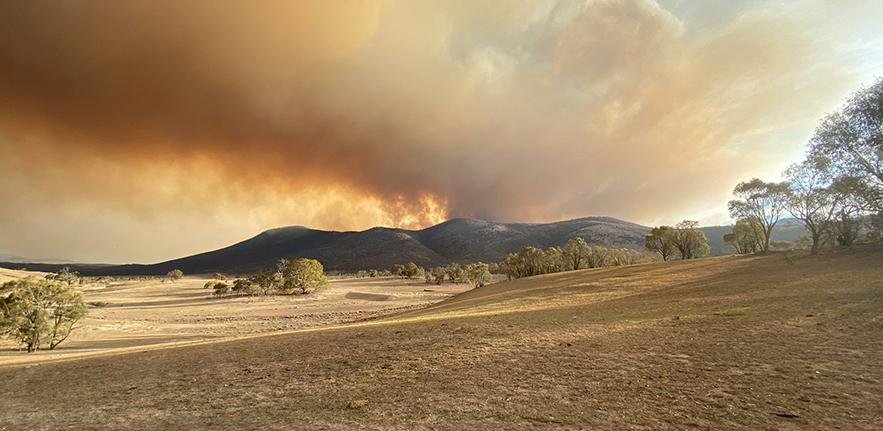
29 January 2020 – Having spent the first days of the new decade escaping the smoke of Australia's devastating bushfires, Amelia Moulis assesses the potential for business leadership to drive climate action in this critical year.
The first day of 2020 set a sombre tone for the climate emergency’s defining decade.
I was at home in Australia, where our local New Years’ Eve fireworks were cancelled. We couldn’t go outside with air pollution almost 40 times above hazardous levels. I was hundreds of miles from the fire fronts but the sky was still deep orange, with flecks of ash dusting the city. It was hot, stifling hot, but the air conditioning was off so the heavy smoke wouldn’t fill our rooms. Smoke alarms were blaring from nearby properties. My mum was shouting flight times across the room so we could avoid road closures surrounding the city. I was messaging friends to check they were alive – until their electricity and communication lines cut out.
For years, 97% of climate scientists have agreed: Earth is moving away from the stable climate which has underpinned every aspect of society, to one shaped by uncertainty and extremes. Australia is living this reality. In 2019, it suffered many effects as predicted by scientists: prolonged drought, flash floods, more intense bushfires, hotter average temperatures – each amplifying the other.
At the time of writing, fires have ripped through 18 million hectares of Australian land – more than England’s total land area of 13 million hectares. They have claimed 33 lives, destroyed over 5,900 buildings, decimated an estimated 1.25 billion animals and impacted a third of all Australians. The scale and intensity is unprecedented. And while individuals and families reflect on what more they could have done, the pressure for action is intensifying and business is also feeling the heat.
Climate change is changing capitalism
The Australian bushfires have negatively impacted business performance, from small farms to Sydney skyscrapers. By early January, smoke haze reduced national economic output by A$500m through lost productivity, spending and healthcare, while Christmas retail sales flat lined, construction and mining sites were forced to close, and postal deliveries stopped. For the areas directly hit by fire, the cost of lost tourism, agricultural and retail income is an estimated A$2 billion and insurance claims are already exceeding A$1.34 billion. Some sectors have been hit further with destroyed crops changing the cost and availability of fresh produce, overseas tourist bookings down 30 – 40%, and around 80,000 livestock properties affected. Total losses are estimated to be A$5 billion, reducing GDP by 0.3% and potentially putting Australia’s AAA sovereign credit rating at risk.
These are our new operating conditions, and they affect the bottom line of all businesses in all sectors. Former Governor of Bank of England, Mark Carney warns that companies that don’t adapt to climate change “will go bankrupt without question”.
The goal is clear
Globally, our goal under the Paris Agreement is to limit warming to 1.5°C to prevent extreme conditions like Australia is experiencing. To achieve this, the Intergovernmental Panel on Climate Change (IPCC) estimates we must collectively remove 27 – 55% of carbon dioxide from the atmosphere by 2030, compared to 2017 levels. CISL’s Corporate Leaders Groups are calling for EU policies to reach net zero greenhouse gas emissions by 2050.
This will require an almost unprecedented level of innovation. It means creating new industries, adjusting others and finding profitable ways to lock carbon dioxide into forests, soils or building materials. It also offers hard choices: there are enough fossil fuel reserves currently on the books of oil companies to shatter 1.5°C. Leaders, particularly in property, infrastructure and mining, have invested capital based on assumptions about the future, expecting it to yield profit. But few will have factored the extreme climate events of 2020 into investment decisions.
Society can either plan the transition or let the changing climate affect every aspect of our lives.
Business is part of the solution
From striking schoolchildren to protestors outside Australian embassies, people are demanding change. Businesses must be part of this solution. Not only do they have the longest planning cycle in an economy and the best capability to innovate, but they are increasingly feeling the pressure. Many recognise climate change will redefine how value is captured and created, amplifying operational risks, changing future legal liabilities, shifting consumer perceptions, and affecting brand value, employer attractiveness, and ultimately business profitability and viability. Despite this, governments in many countries are not setting policy conditions that offer strong market confidence and incentives for business to transition. This means business must take leadership in the absence of clear government direction.
Siemens, for instance, did not foresee how a contract supported by the Australian government and worth only 0.2% of its annual revenue – to deliver rail signalling for a proposed Australian coal mine – could result in millions of dollars of reputational damage as protesters rallied outside its buildings in the midst of the fires. Investors are now arguing that the board failed in its fiduciary duty and Siemens’ Chief Executive admitted, “We should have been wiser about this project beforehand.”
Many of our clients at CISL recognise it is in their interests to make sure the transition to a zero carbon economy is managed. We have seen increasing interest for Executive Education from Boards and senior leadership teams across all sectors as they look to reshape their business strategy in order to reduce climate risk. These businesses understand that proactive engagement with the climate debate is good for business.
Decisive action is required
Capturing value in a hotter and more unpredictable world will require decisive action. Our work indicates that leading businesses are finding ways to adapt: aligning their strategies with climate goals, redesigning manufacturing processes, finding new business models or redefining their unique purpose and contribution to a radically different world. They are recognising the climate emergency as the biggest innovation agenda on the planet. This is testament to the strong economic, moral, and ethical case for business leaders to respond. But there’s also huge risk in not responding.
The IPCC has stated that climate change is manmade and outlined anticipated effects on weather patterns. This means droughts and fires across Australia are not an unforeseeable risk, and not an ‘act of God’. How many companies have taken insurance to cover that, and how will the insurance market adapt?
Legal liabilities are also becoming clearer with 1,442 climate lawsuits heard globally. Many large carbon emitters such as BP, ExxonMobil and Shell have already faced civil action. Torres Strait Islanders have taken on the Australian government on the belief that inaction on climate change has violated their human rights. Australian pension fund, REST, is being sued for not protecting customer investments from climate risk. Cases like these are fundamentally rewriting public expectations of leaders.
Alongside this, reporting requirements are swiftly changing. Large businesses are volunteering to adopt guidance from the Task-force for Climate-Related Financial Disclosure (TCFD). Financial regulators and institutions – from the Australian Prudential Regulatory Authority to BlackRock and the Bank of England – have supported advice that company directors must understand, disclose and mitigate climate risks as part of their standard duty of care. As BlackRock CEO Larry Fink states, “Climate risk is investment risk.”
But while the tone is changing, most businesses have yet to seriously calibrate to the size of the climate challenge. In doing so, they can position for long-term advantage, stimulate innovation and effectively mitigate risk. Getting this right is not easy. But responding to the climate emergency is the defining challenge of this decade.
CISL runs annual education programmes in Australia, including the Sustainability Practitioner Programme and Non-Executive Director Programme, and customised programmes on request.





